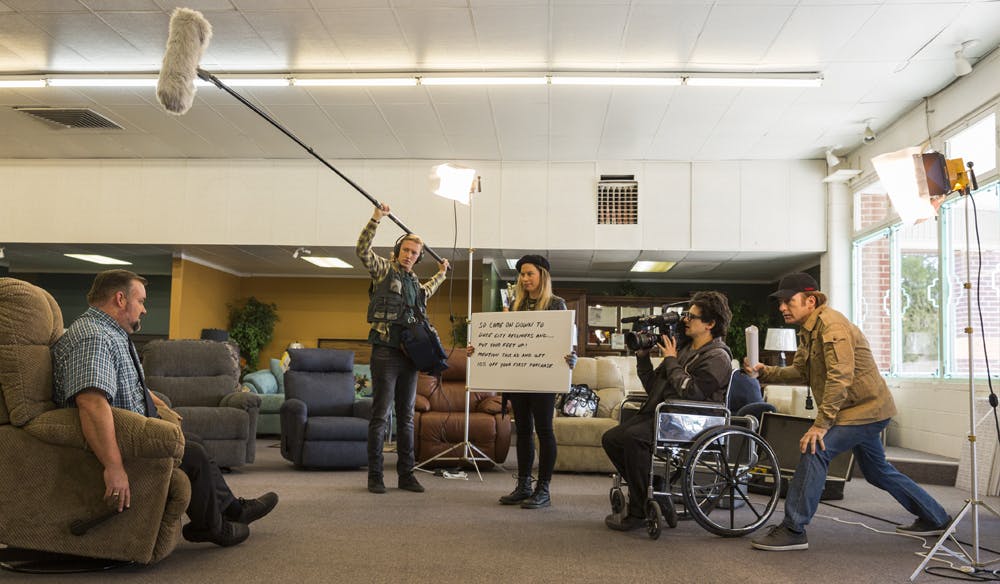During SourceCon Atlanta one of the most memorable tips for me came from Tim Sackett’s keynote. In his keynote, Sackett described using video messaging as a method for initial contact to candidates. Although this advice was memorable, it wasn’t until about two weeks ago that I decided to dive in and start making videos for sourcing. After a long stretch of being ignored by countless software developer candidates when they’re becoming a critical need for our team, I decided that I could no longer put off trying a method that many of my fellow sourcers have said can yield anywhere from a 70-90% response rate. In this tight labor market, it’s clear that we’re in a war on both talent, and engagement. As someone who is an avid enthusiast of sketch comedy, I saw this as an opportunity to incorporate some of my ideas that come to me on a daily basis.
I’ll be the first to say that I have minimal experience with film, editing or directing. Admittedly, I can see why the prospect of creating your content can be intimidating, especially when there is so much content already out there that is high production and quality. Most of the videos I’ve done in the past have been purely for fun such as making videos of my sketches that are inside jokes for friends and family. What I’m coming to discover, however, is that video messaging for passive candidates, doesn’t have to be expensive, or high production quality to be adequate.
The First Video
For my first sourcing related video, I wrote up a quick blurb that flowed by making our IT department’s technology stack into puns that fit into our general message. I then asked one of my co-workers to record it, and we finished in about 15 minutes. I did a test run with five web developer profiles that perfectly fit into the desired skillset. The messaging to the candidate was framed as telling the candidate to watch this cheesy video I made. Even if they weren’t interested in working for us, I promised to give them at least a good laugh. Within an hour of sending this video, three of the five highly qualified candidates responded saying how much they loved the puns and wanted to be part of our team. Upon further review, all three of those candidates were approved to move forward with hiring manager interviews. Word of the video spread quickly across all departments, and the response was overwhelmingly positive. I was then asked by several individuals in senior leadership to create more of these videos.
The Second Video
For my second video project, I decided to do something I have always wanted to do, a parody of the infomercial format. I wanted the video to appeal to all departments, so I put the focus on a simple aspect of our company’s culture, our casual dress code. Anyone who has seen an infomercial knows there is always an introduction shot in black and white that makes the everyday mundane task look impossible, almost comical. We did the same with dressing professionally for work. We depicted things like typing, answering the phone, or drinking coffee as painfully difficult in blazers and dress shoes. Halfway through the video, the picture went from black and white to color once we showed our employees thriving in casual attire.
Of course, no infomercial would be complete without an ending scene asking viewers to “call now!” We had one that said that candidates could interview at FTD for just three easy payments of $0.00. When sending it to candidates, we used the subject line “Is your current job like living in a bad infomercial?” It was enough to not only get candidates to open our messages but to respond almost immediately.
The Response
Suddenly I was getting flooded with interested candidates after weeks of rejection. Their responses weren’t just about being excited by the job or that they could wear jeans to work. The video showed that they would be working with others that have a sense of humor, and willingness to execute on creative ideas. The footage was free to produce, and all I needed was the help of my fellow TA team members. It was shot on an iPhone and edited with iMovie.
If you want to dabble in directing your sourcing video, there are plenty of resources available. Here are just a few to help you get started if you’re brand new to creating content.
iMovie– If you have an iPhone it is already downloaded onto your device. It’s easy and intuitive to use. You can add voiceover, sound effects, and transitions between clips.
Storyboardthat– Before presenting the story for the infomercial to the TA team, I created a storyboard on what the concept. This resource is free, and you can create two storyboards per week. You can purchase a premium membership with unlimited for $10 a month.
Lumen5– This tool is a favorite tool of Greg Hawkes. You can paste in URLs from articles, and it uses A.I. to create a video that summarizes the content. There is a free option with multiple premium options.
Placeit– This resource is excellent for templates which can be used in videos and you can even insert your logo. There is a free membership, and for unlimited template downloads, it’s $29 a month.
